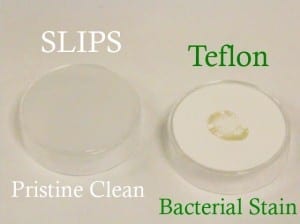Slippery technology shown to prevent more than 99% of harmful bacterial slime from forming on surfaces.
Biofilms may no longer have any solid ground upon which to stand.
A team of Harvard scientists has developed a slick way to prevent the troublesome bacterial communities from ever forming on a surface. Biofilms stick to just about everything, from copper pipes to steel ship hulls to glass catheters. The slimy coatings are more than just a nuisance, resulting in decreased energy efficiency, contamination of water and food supplies, and—especially in medical settings—persistent infections. Even cavities in teeth are the unwelcome result of bacterial colonies.
In a study published in the Proceedings of the National Academy of Sciences(PNAS), lead coauthors Joanna Aizenberg, Alexander Epstein, and Tak-Sing Wong coated solid surfaces with an immobilized liquid film to trick the bacteria into thinking they had nowhere to attach and grow.
“People have tried all sorts of things to deter biofilm build-up—textured surfaces, chemical coatings, and antibiotics, for example,” says Aizenberg, Amy Smith Berylson Professor of Materials Science at the Harvard School of Engineering and Applied Sciences (SEAS) and a Core Faculty Member at the Wyss Institute for Biologically Inspired Engineering at Harvard. “In all those cases, the solutions are short-lived at best. The surface treatments wear off, become covered with dirt, or the bacteria even deposit their own coatings on top of the coating intended to prevent them. In the end, bacteria manage to settle and grow on just about any solid surface we can come up with.”
Taking a completely different approach, the researchers used their recently developed technology, dubbed SLIPS (Slippery-Liquid-Infused Porous Surfaces) to effectively create a hybrid surface that is smooth and slippery due to the liquid layer that is immobilized on it.
First described in the September 22, 2011, issue of the journal Nature, the super-slippery surfaces have been shown to repel both water- and oil-based liquids and even prevent ice or frost from forming.
“By creating a liquid-infused structured surface, we deprive bacteria of the static interface they need to get a grip and grow together into biofilms,” says Epstein, a recent Ph.D. graduate who worked in Aizenberg’s lab at the time of the study.
“In essence, we turned a once bacteria-friendly solid surface into a liquid one. As a result, biofilms cannot cling to the material, and even if they do form, they easily ‘slip’ off under mild flow conditions,” adds Wong, a researcher at SEAS and a Croucher Foundation Postdoctoral Fellow at the Wyss Institute.
Aizenberg and her collaborators reported that SLIPS reduced by 96–99% the formation of three of the most notorious, disease-causing biofilms—Pseudomonas aeruginosa, Escherichia coli, and Staphylococcus aureus—over a 7-day period.
via Harvard University
The Latest Streaming News: Slippery coating technology updated minute-by-minute
Bookmark this page and come back often
Latest NEWS
Latest VIDEO








